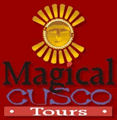 |
| Click On This Photo For Professional High Quality Peru Tours From Magical Cusco Tours Just Mention delange.org With Code Inka2010 Get A 4% Tour Discount With Any Package Tour Purchase! |
|---|
Pictures, Photos, Images, & Reviews.
Google Map To Cusco or Cuzco, Peru.
View Larger Map
History: The Inca empire, which lasted from the 11th century to its Conquest in the early 16th century, was one of the greatest planned societies the world has ever known, and the beauty and enchantment of Cuzco reflect that. There is so much history here that it can be difficult to keep it all straight, particularly when much of it involves myths and legends. To know the beginning of Cuzco, you must first know how the Incas began. It is said that the Inca civilization began when the Creator and sun god Viracocha's offspring Manco CapacManco Capac, legendary founder of the Inca dynasty of Peru (the first ruling Inca) and Mama Occlo arose from the Isle de Sol in Lake Titicaca. Lake Titicaca sits 3,812 m (12,507 feet) above sea level making it the highest commercially navigable lake in the world. By volume of water it is also the largest lake in South America. Somewhere near Copacabana, Bolivia. They were sent with a golden rod to find the Q'osqo or navel of the world and to begin the civilization. Manco Capac was commanded to find a place where he could push the rod into the ground until it disappeared. When he found it, that was to become the center of the universe. The original shape of Cuzco was in the form of a puma. Roads and canals formed the outline of the body and legs, while Sacsayhuaman was the head and its 22 zigzagged walls formed the teeth The capital of the Incan Empire is thought to have been founded around 1100 AD. Previously Peru had been ruled by a number of cultures. What the Inca did was establish a central government that united them all and they ran it from here. They were not the scientists and creators of culture that the others were, but they were able to absorb the lifestyle improvements that others had achieved and combine them all, which was perhaps an even greater feat. Other cultures occupied the area, such as the Wari's who were there in the eighth and ninth century. The first Incas arrived in the 12th century. Other than a few small palaces, the first eight rulers did little that was to be remembered. They controlled the area around Cuzco, but expansion was minimal. It wasn't until the Chanka culture arrived to take over the Inca, that expansion began. During the rule of Pachacutec, Cuzco developed greatly. Rivers were diverted, buildings such the Qoricancha temple and other palaces were constructed, and the layout of the city was set. Ahuge central plaza became the center of all social activities. When the Spanish forces arrived in Cusco in 1533 after capturing Atahualpa, they were hailed because he was seen as a traitor. They believed the Spanish would reinstall To go through the installation process once again, because files have become corrupted. See reload. Huascar, but Atahualpa ordered him executed. Soon after, the Spanish began razing the city and took control. In 1536, a rebellion by Manco Inca and his troops nearly took it back. In 1537, a struggle for power from the Spanish side began and Diego de Almagro also known as El Adelantado and El Viejo seized Cuzco from Hernando Pizarro. A year later Pizarro would the city and Almagro would be executed. Over the next few decades the Spanish would rebuild much of the city, creating the Plaza de Armas. The Plaza de Armas (Plaza of Arms) is the name for the main square in many Latin American cities. While some large cities have both a Plaza de Armas and a Plaza Mayor, in most cities those are two names for the same place. . They tried to instill Catholicism into the hearts and minds of the people, and eventually succeeded, as you can see by the devout religious practice in the city today. Integrating Catholicism into Quechua life was not easy. Festivals would involve heavy drinking (which still occurs). And the population only gradually relinquished all of their pagan ways. For instance on Corpus Christi holiday they would parade the mummies of the Inca rulers through the streets. The mummies were later replaced by 15 religious images. After the Spanish gained control of the entire country, and with the founding of Lima in 1535, the center of Peru shifted to the coast and the importance of Cuzco dwindled. A 1650 earthquake destroyed many of the Incan buildings, leading to Cuzco's rebuilding in a mostly Baroque style. The last decade has returned prominence to Cuzco, this time because of tourism. The city is growing now, with new hotels, restaurants, and museums appearing almost weekly and the pace still cannot accommodate the increasing number of tourists. This is really just the beginning. Cuzco is leading the way for tourism to the entire continent and the bubble is unlikely to burst anytime soon. The official name of the city has been changed back to the Quechua: Qosq'o. Most street names have been changed to Quechua as well, although both spellings are generally used and accepted. The most popular churches and cathedrals to visit in Cusco are: The cathedral, San Blas Church, Santa Catalina Convent, San Francisco, La Merced, Compa�ia de Jesus Church, Belen Church, San Sebastian Church and Parish, Santa Teresa Monastery, Santa Clara Convent and Church, La Recoleta Convent Church, San Cristobal Church, San Cristobal Parish, Santa Ana Parish and San Pedro Church. Walking through the narrow streets of Cusco next to the ancient Inca Walls is like walking through an outdoor museum. The original Inca ruins often serve as the foundations of the buildings in the city of Cusco as it exists today. There are a few areas where the Inca Walls stand out more than others. Some of the best areas to see Inca Walls are along the streets of Loreto and Hatunrumiyoc. Inca walls line both sides of Loreto, which runs southeast from the Plaza de Armas. The south wall is from Amarucancha, site of the Palace of Huayna Capac. On the north side of Loreto is the wall which belonged to the Acllahuasi and is one of the oldest walls in Cusco. Hatunrumiyoc runs northeast from the Plaza de Armas. This pedestrian only street is famous for the 12 sided stone found along the east wall. To find the stone look for the souvenir sellers which set up regularly directly across from the stone. The Church of Santo Domingo, which is also the site of Coricancha is another great example of Inca stone work. A curved, 6m high Inca wall lines one end of the Church of Santo Domingo and can be seen from the street or inside the church.
|
The Alejandro Velasco Astete International Airport (IATA: CUZ, ICAO: SPZO) is located in the city of Cusco, a city in southeastern Peru. Cusco, a principal tourist attraction in Latin America, receives various domestic flights as well as some international flights. There are several Guided Tour Agencies offering standard city and archaeological tours of the areas of Cusco.
This page is for information purposes only and while we have made every effort to be accurate, it is the travelers responsibility to make the appropriate choice as to which hotels to use in Peru.
We found that when touring Peru, Magical Cusco Tours gave us the best service of all. They even arranged very personal tours based upon our ages and experience. They were there for us whenever we needed them. Click on any of their links on our pages and they will give you a 4% discount for taking their package tours. Mention delange.org. Merchant Code Inka2010 for your discount! We suggest letting Ana Maria handle your tour. Note: The 4% discount applies to package tours only! Discount does not apply to hotel bookings, domestic or international tickets, meals or any other service booked as a single activity.
Magical Cusco Tours also has a culinary tour that you may enjoy.Click Here For: Taste Of Peru.com their culinary tour page.
We also have links to Priceline.Com on our pages, in case you may prefer to use their services.
|
 |
| Cusco City Map. |
|---|
We Are Proud Of Our SafeSurf Rating!

Click On Any Of The Following Links By Amazon.Com
For Books About Hiking Or Touring In Peru.
Some Are Must Have Books - If You Are Going To Peru.
We Also Are Including Some Great Music CD's & DVD's. No Obligation!

To Cusco Places To Visit Page
Back To Cusco Main Page
To Cusco To Puno Tours Page Two
Cusco To Puno Tours Page Three
To Cusco To Puno Tours Page Four
Back To Puno Tours Main Page
Back To Peru Tours Main Page
Back To DeLange Home Page






